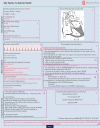Effect of clinical decision support systems on emergency medicine physicians' decision-making: A pilot scenario-based simulation study
- PMID: 36589162
- PMCID: PMC9798305
- DOI: 10.3389/fped.2022.1047202
Effect of clinical decision support systems on emergency medicine physicians' decision-making: A pilot scenario-based simulation study
Abstract
Background and objectives: Children with congenital heart disease (CHD) are predisposed to rapid deterioration in the face of common childhood illnesses. When they present to their local emergency departments (ED) with acute illness, rapid and accurate diagnosis and treatment is crucial to recovery and survival. Previous studies have shown that ED physicians are uncomfortable caring for patients with CHD and there is a lack of actionable guidance to aid in their decision making. To support ED physicians' key decision components (sensemaking, anticipation, and managing complexity) when managing CHD patients, a Clinical Decision Support System (CDSS) was previously designed. This pilot study evaluates the effect of this CDSS on ED physicians' decision making compared to usual care without clinical decision support.
Methods: In a pilot scenario-based simulation study with repeated measures, ED physicians managed mock CHD patients with and without the CDSS. We compared ED physicians' CHD-specific and general decision-making processes (e.g., recognizing sepsis, starting antibiotics, and managing symptoms) with and without the use of CDSS. The frequency of participants' utterances related to each key decision components of sensemaking, anticipation, and managing complexity were coded and statistically analyzed for significance.
Results: Across all decision-making components, the CDSS significantly increased ED physicians' frequency of "CHD specific utterances" (Mean = 5.43, 95%CI: 3.7-7.2) compared to the without CDSS condition (Mean = 2.05, 95%CI: 0.3-3.8) whereas there was no significant difference in frequencies of "general utterances" when using CDSS (Mean = 4.62, 95%CI: 3.1-6.1) compared to without CDSS (Mean = 5.14 95%CI: 4.4-5.9).
Conclusion: A CDSS that integrates key decision-making components (sensemaking, anticipation, and managing complexity) can trigger and enrich communication between clinicians and enhance the clinical management of CHD patients. For patients with complex and subspecialized diseases such as CHD, a well-designed CDSS can become part of a multifaceted solution that includes knowledge translation, broader communication around interpretation of information, and access to additional expertise to support CHD specific decision-making.
Keywords: clinical decision support (CDSS); congenital heart disease; decision making; digital health; emergency medicine; macrocognition; pediatric.
© 2022 Assadi, Laussen, Freire, Ghassemi and Trbovich.
Conflict of interest statement
The authors declare that the research was conducted in the absence of any commercial or financial relationships that could be construed as a potential conflict of interest.
Figures


Similar articles
-
Decision-centered design of a clinical decision support system for acute management of pediatric congenital heart disease.Front Digit Health. 2022 Nov 14;4:1016522. doi: 10.3389/fdgth.2022.1016522. eCollection 2022. Front Digit Health. 2022. PMID: 36452427 Free PMC article.
-
Understanding Clinician Macrocognition to Inform the Design of a Congenital Heart Disease Clinical Decision Support System.Front Cardiovasc Med. 2022 Feb 3;9:767378. doi: 10.3389/fcvm.2022.767378. eCollection 2022. Front Cardiovasc Med. 2022. PMID: 35187118 Free PMC article.
-
Mixed-methods approach to understanding clinician macrocognition in the design of a clinical decision support tool: a study protocol.BMJ Open. 2020 Mar 25;10(3):e035313. doi: 10.1136/bmjopen-2019-035313. BMJ Open. 2020. PMID: 32213525 Free PMC article.
-
Clinical Decision Support Systems for Triage in the Emergency Department using Intelligent Systems: a Review.Artif Intell Med. 2020 Jan;102:101762. doi: 10.1016/j.artmed.2019.101762. Epub 2019 Nov 17. Artif Intell Med. 2020. PMID: 31980099 Review.
-
The changing nature of clinical decision support systems: a focus on consumers, genomics, public health and decision safety.Yearb Med Inform. 2009:84-95. Yearb Med Inform. 2009. PMID: 19855878 Review.
Cited by
-
The Application of Knowledge-Based Clinical Decision Support Systems to Enhance Adherence to Evidence-Based Medicine in Chronic Disease.J Healthc Eng. 2023 May 29;2023:8550905. doi: 10.1155/2023/8550905. eCollection 2023. J Healthc Eng. 2023. PMID: 37284487 Free PMC article. Review.
-
Designing and testing clinical simulations of an early warning system for implementation in acute care settings.JAMIA Open. 2024 Oct 16;7(4):ooae092. doi: 10.1093/jamiaopen/ooae092. eCollection 2024 Dec. JAMIA Open. 2024. PMID: 39415945 Free PMC article.
References
LinkOut - more resources
Full Text Sources

